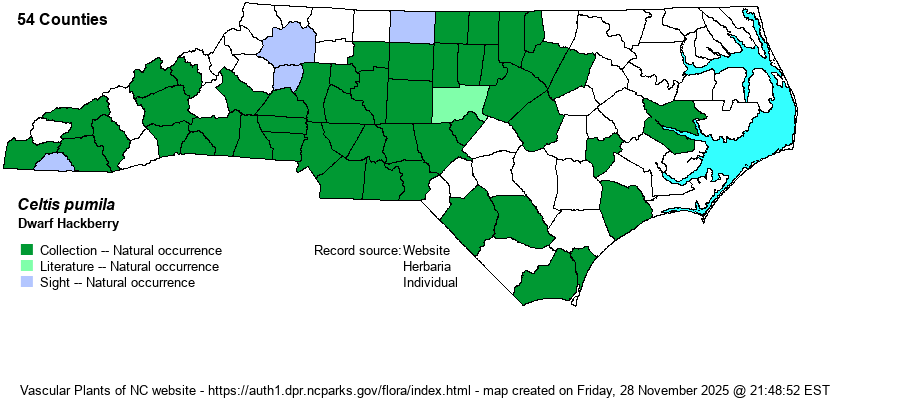| Author | Pursh | |
| Distribution | Primarily found in the Piedmont, though perhaps absent from some far northwestern counties. Widely scattered in the western and southern Coastal Plain and in the southern half of the Mountains. Likely absent from the northern Mountains.
This species occurs from PA and KS south to northern FL and central TX. It is scattered over most mountain ranges, despite its seeming absence from the northern NC Mountains. | |
| Abundance | Infrequent to locally fairly common in most of the Piedmont, but sparsely distributed. Rare to uncommon in the western and southern Coastal Plain and in the southern half of the Mountains. | |
| Habitat | As with other Celtis species, it strongly favors high pH soils. This species shuns wetland sites and occurs mainly in upland glades, dry and xeric forests, bluffs, and rocky woods. It may at times occur along stream banks, but mainly where somewhat rocky. |
| Phenology | Flowers in April and May; fruits from August to October. | |
| Identification | This is a large deciduous shrub to more often a very small tree, growing mainly to about 20 feet tall. Because it is a small tree, the warty tubercles on the bark are often not obvious, and most observers will need to identify the species by leaf characters. It has thin but scabrous (above) alternate leaves, widely ovate, only to about 2 inches long, and about two-thirds as wide, with a narrowly acuminate tip. The leaves can be entire or moderately serrate on the margins; this variation of leaf serration suggests that perhaps two varieties are present in the state. The quite similar C. occidentalis, with which it has often been lumped, has larger leaves that average about twice as long as wide, has distinct serrations (many), and has larger fruit (if visible). Nonetheless, both species grow in upland soils and theoretically could occur together, though this species is primarily a Piedmont species and C. occidentalis is a taller tree primarily of the mountains. You may need to check floral keys for further separation. | |
| Taxonomic Comments | Though most references, both in the past and currently, consider this a good species, some had lumped it with C. occidentalis, mostly as C. occidentalis var. georgiana. A few other names have been used in the past. Weakley (2020) stats that: "C. pumila Pursh has priority over C. tenuifolia Nuttall; the description in Pursh's flora ("a small straggling bush"), and more critically the type specimen, conform to what has more generally been known as C. tenuifolia (Whittemore in Yatskievych 2013)."
| |
| Other Common Name(s) | Georgia Hackberry | |
| State Rank | S3 [S4] | |
| Global Rank | G5 | |
| State Status | | |
| US Status | | |
| USACE-agcp | | |
| USACE-emp | | |

